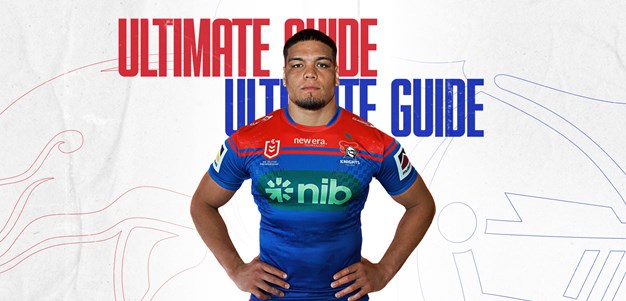

In what year did a team from Newcastle first enter the NSWRL (Now the NRL)?
You might answer 1988. If you did, you're wrong.
It sure stumped most of you, with the majority of participants getting the question wrong in yesterday's Knights History Quiz.
The correct answer is actually 1908, the year rugby league itself was founded in Australia.
Confused? We don't blame you.
Many believe professional rugby league in the Hunter began with the Knights' entry into the Winfield Cup in 1988, however the sport has a long and storied history before the team in red and blue entered the competition.
Rewinding back to pre-World War I times, and rugby union was experiencing a wave of popularity off the back of a talented player named Dally Messenger (yes, of Dally M Medal fame).
The success of union was great for the sport, with exponential growth in ticket sales lining the pockets of the governing bodies.
Unfortunately for Messenger and his colleagues, none of this cash was filtering down to the players.
In fact, the Rugby Football Union (RFU), the governing body of the competition based in the UK, enforced a blanket law of amateurism for all players.
That means you weren't paid or compensated for time off work caused by game clashes or injuries.
With working class players beginning to discover their own worth, the New South Wales Rugby Football League (NSWRFL) was formed in 1907 with the aim of establishing a new variation of rugby called rugby league, which had been played in England since 1895.
The new body promised injury compensation and other benefits for players, which was enough to entice Messenger across in a move which shocked the sporting landscape at the time.
Coming into 1908, the NSWRFL was ready to launch and eight foundation Clubs across Sydney began to form throughout January.
Eastern Suburbs, South Sydney, North Sydney, Western Suburbs, Balmain, Newtown, Cumberland and Glebe were all set and ready to go.
However, this wasn't enough for the NSWRFL, who were desperate to add a ninth side based outside of Sydney to drive growth and increase support for the new sport.
So, back to Newcastle.
A public meeting on the 10th of February failed to form the rugby league Club, and the idea of a Newcastle team in the Sydney competition seemed dead.
However, the powers that be in the Hunter, lead by Arthur Chambers, continued to negotiate with the NSWRFL.
James J. Giltinan, an entrepreneur leading the charge for the formation of the new league, continued to visit Newcastle in secret.

With the local rugby union body threatening sanctions against any rebel players considering jumping ship, recruitment for a potential team continued in secret.
The clock was well and truly ticking for the formation of any new Clubs as an April 20 deadline quickly approached.
Then, on April 10, 15 players who had been isolated from the rugby community, known as the Rebel Pioneers, met outside the Central Hotel and agreed to form the Newcastle Rugby League football club.
The formation was solidified with all players signing a cigarette packet.
The NSWRFL even agreed to cover the new team's travel costs between Newcastle and Sydney.
When you consider there was no M1 and the country's first petrol-driven car had only been developed in 1901, this was a substantial outlay to secure the new team.
It showed the NSWRFL believed Newcastle, a working class community, was a key growth area for this new sport.
Thus, the Newcastle Rugby League Club was formed and were given just ten days to prepare for their first match against Glebe.
Dubbed the 'Rebels', Newcastle adopted a red and white hooped jersey and fielded a strong side in the new competition.
They boasted the likes of dual-code international Pat Walsh, while William Bailey and Arthur Coleman were also strong additions.
Stan Carpenter was the original captain of the Club, with Ted McGuinness as his Vice.

The Rebels kicked off their season against Glebe, going down 8-5 in a tight affair.
They would go on to win four of their remaining eight games, finishing the season in 5th place and just missing out on a semi final spot.
The highlight of the season was a 37-0 win over Cumberland in Round 3, while the Club also featured in front of over 14,000 fans in a 17-8 win over Newtown in Round 6.
Returning in 1909, the Rebels had an improved season, winning five games and finishing equal third alongside Eastern Suburbs.
They even managed to play three of their games in Newcastle, with the team playing in front 3,000 fans at the Newcastle Showground.
In a sudden death semi final, the Rebels were outclassed 20-0 by eventual premiers South Sydney, which unfortunately marked their final ever appearance in the competition.
Ahead of the 1910 season, the Rebels were decimated by the announcement that Newcastle would establish its own competition to rival the NSWRFL.
Many of the Club's players opted to sign with the four foundation Clubs in the Hunter, and the Rebels were officially disbanded.
They were replaced by Annandale in the NSWRFL, who went on to enjoy 11 years in the competition before they too were omitted in 1920.
And so, the Hunter was left without a Club until the formation of the Knights, who joined the NSWRL 79 years after Newcastle last took part in the competition.
While consigned mostly to the history books, the Knights did formally nod to those who lead the way all those years ago by wearing a replica red and white strip for two matches in the 2008 centenary season.
The Heritage strip introduced generations to the long and mostly forgotten story of the original group of rebels who introduced a region to the sport it would ultimately adopt as its favourite Winter past time.
Which, in itself, is incredibly significant.





